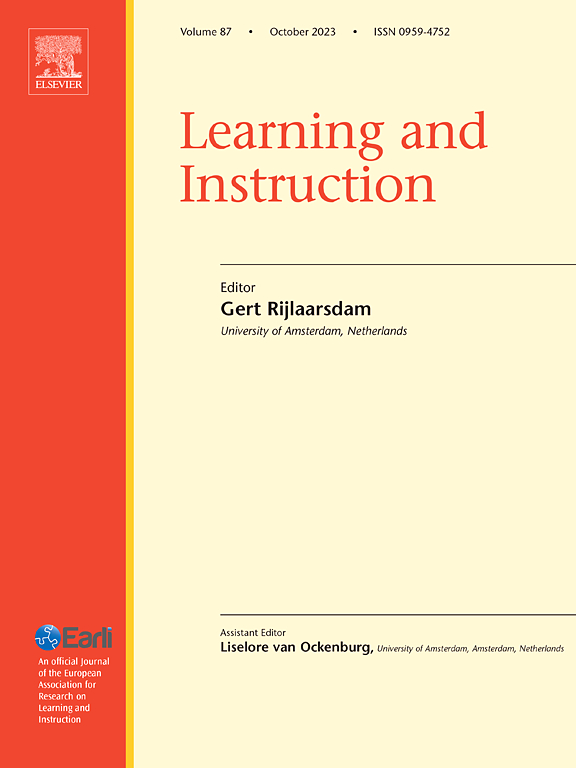COVID-19-related differences in students’ verbal achievements: Comparisons of different cohorts of students with SEN based on large-scale assessment data from Germany
IF 4.9
1区 教育学
Q1 EDUCATION & EDUCATIONAL RESEARCH
引用次数: 0
Abstract
Background
Restrictions on schooling related to the COVID-19 pandemic resulted in learning deficits in primary and secondary education, but may have affected different groups of students in different ways.
Aim
We focus on the especially vulnerable group of students with special educational needs (SEN) in the domain of learning (SEN-L) and investigated changes in their verbal achievements by comparing different student cohorts. We also analyzed whether characteristics of the learning situation during the pandemic differed between students with and without SEN and whether these characteristics were associated with students’ verbal achievements.
Sample
Analyses are based on representative data from large-scale assessments in Germany with achievement scores available for student cohorts prior to the COVID-19 pandemic and for student cohorts affected by the pandemic-related restrictions (Grade 4: 2016/2021, Nnon-SEN/SEN-L > 23.300/1.500; Grade 9: 2015/2022, Nnon-SEN/SEN-L > 29.000/1.300).
Results
Significant negative trends in student cohorts' average achievement emerged in reading, listening, and orthography for SEN-L students taught at regular schools and their peers without SEN. Negative cohort trends in achievement were also found for SEN-L students at special needs schools, but these were not statistically significant in all domains. Multilevel regressions revealed significant relations between students’ learning conditions during the pandemic and their verbal achievement in 2021/2022, but did not differ between students without SEN and students with SEN-L.
Conclusion
The findings indicate negative trends in verbal achievements for students with SEN-L at regular schools and at special needs schools. These are likely in part due to the pandemic-related restrictions in schooling.
与新冠肺炎相关的学生语言成绩差异:基于德国大规模评估数据的不同SEN学生队列比较
与COVID-19大流行相关的学校限制导致中小学教育的学习缺陷,但可能以不同的方式影响不同群体的学生。我们关注在学习领域有特殊教育需要(SEN)的学生群体(SEN- l),通过比较不同的学生群体,调查他们在语言成绩方面的变化。我们还分析了大流行期间学习情况的特征在有特殊学习障碍和没有特殊学习障碍的学生之间是否存在差异,以及这些特征是否与学生的语言成绩有关。样本分析基于德国大规模评估的代表性数据,这些数据包括COVID-19大流行之前的学生群体和受大流行相关限制影响的学生群体的成绩分数(4级:2016/2021,non- sen /SEN-L > 23.300/1.500; 9级:2015/2022,non- sen /SEN-L > 29.000/1.300)。结果普通学校SEN-L学生和非SEN-L学生在阅读、听力和正字法上的平均成绩呈显著负向趋势,特殊需要学校SEN-L学生的成绩也呈负向趋势,但在所有领域均不具有统计学意义。多水平回归显示,疫情期间学生的学习状况与2021/2022学年的语言成绩之间存在显著关系,但在非SEN学生和SEN- l学生之间没有差异。结论普通学校和特殊需要学校SEN-L学生的语言成绩呈下降趋势。这在一定程度上可能是由于与大流行有关的学校限制。
本文章由计算机程序翻译,如有差异,请以英文原文为准。
求助全文
约1分钟内获得全文
求助全文
来源期刊

Learning and Instruction
Multiple-
CiteScore
11.30
自引率
4.80%
发文量
109
期刊介绍:
As an international, multi-disciplinary, peer-refereed journal, Learning and Instruction provides a platform for the publication of the most advanced scientific research in the areas of learning, development, instruction and teaching. The journal welcomes original empirical investigations. The papers may represent a variety of theoretical perspectives and different methodological approaches. They may refer to any age level, from infants to adults and to a diversity of learning and instructional settings, from laboratory experiments to field studies. The major criteria in the review and the selection process concern the significance of the contribution to the area of learning and instruction, and the rigor of the study.
 求助内容:
求助内容: 应助结果提醒方式:
应助结果提醒方式:


